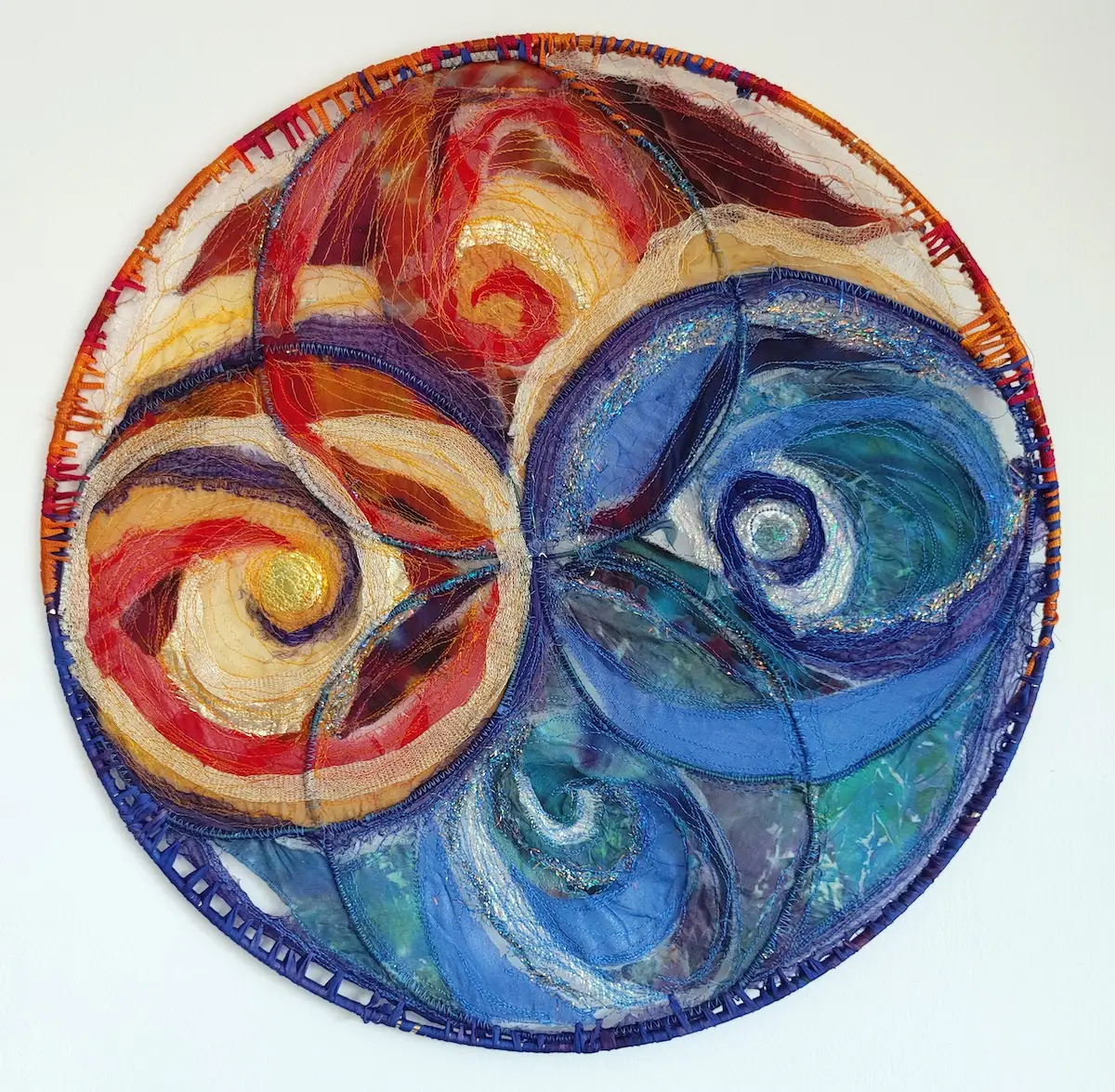For Sonja Lee-Austin, making art has never been optional—it’s simply who she is. Her layered textile pieces weave together memory, symbolism, and curiosity.

Can you tell us about the very first time you felt like an artist?
I don’t remember ever not feeling like an artist. I have always loved drawing, color, and making things. One of my earliest memories is that sometimes I would go to my mom’s office and use up her tape making 3-D paper robots for her coworkers from printer paper and tape.
How did your background or upbringing shape the kind of work you create today? What role did family, community, or teachers play in encouraging your creativity?
Living in Lowell, Massachusetts, a center of the American textile industrial revolution and the location of the New England Quilt Museum (NEQM), helped to ensure my love of incorporating textiles into my art. The NEQM introduced me to art quilts which inspired me as a new and exciting way to honor and build on women’s historical connection to working with fabric such as sewing clothes, quilts, and household items.
As an Amazon Associate I earn from qualifying purchases. Read more about our affiliate linking policy.
I was inspired by seeing Ruth McDowell’s art quilts at NEQM from her tessellation quilts to pattern-on-pattern quilts to nature quilts. One of my favorites is her Twelve Dancing Princesses quilt with its shimmery fabrics. I love how she combines all kinds of fabrics instead of just quilters cotton.
My mom and grandmas introduced me to sewing and embroidery skills, too. My mom’s mom was always sewing something. She sewed me a “Cabbage Patch Kid” when the dolls were so popular in the early 80’s that they sold out and she made my favorite flannel nightgown with the puffy sleeves like the book character Anne of Green Gables would have liked. She also made me a quilt for college in fabrics of my favorite color, blue.
My mom also started to quilt when I was growing up and took some quilting classes at NEQM including one with Ruth McDowell. She started by hand quilting some unfinished quilts that my grandma (my dad’s mom) gave her and then she got into making kaleidoscope quilts like Paula Nadelstern and quilts inspired by Ruth McDowell’s pattern-on-pattern and nature quilts.

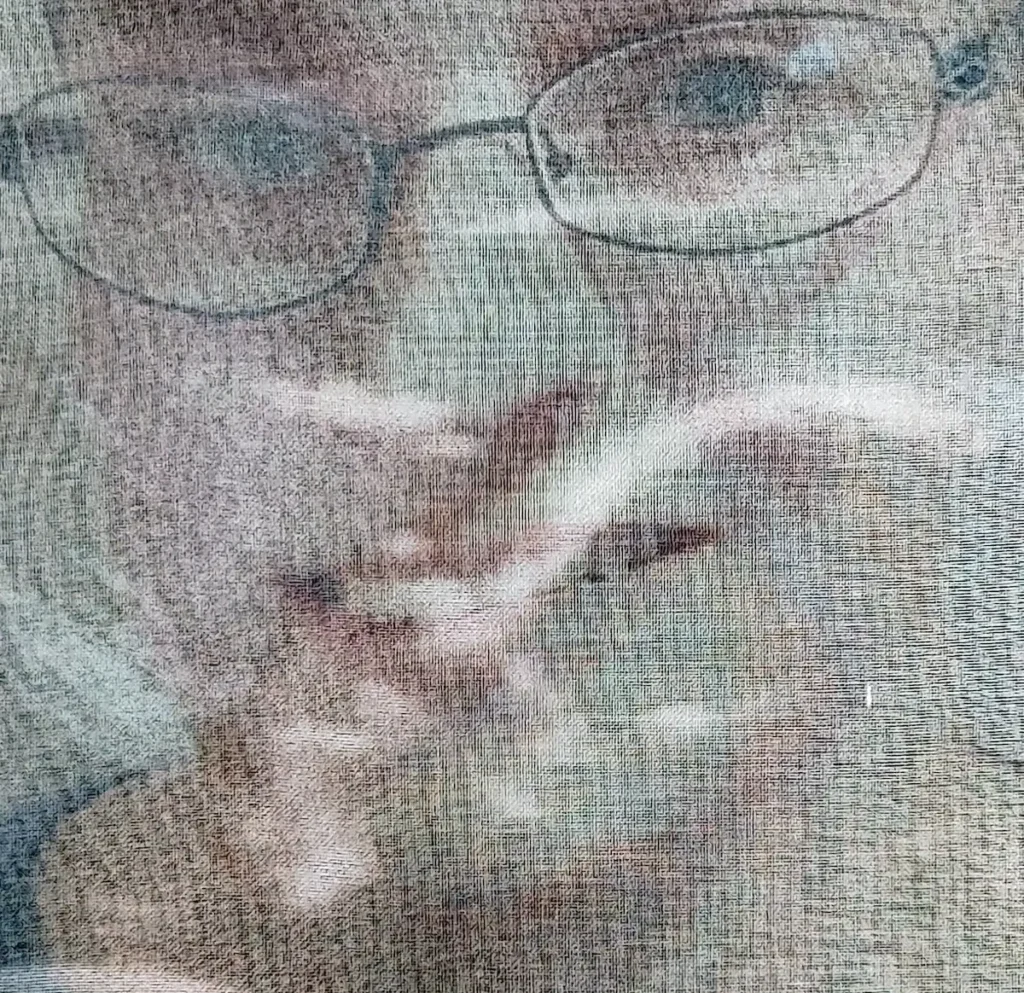
Looking back, was there a defining moment when you knew this was your life’s path?
Not really. I can’t remember a time when I didn’t want to make art and pursue it as my path.
I’ve had doubts about where art fits in my career path. I got a bachelor’s degree in studio art from Saint Olaf College in Minnesota thinking that I would do something art related as a career path.
My parents encouraged me to take statistics in college and get a well-rounded education so my career options would not be too limited. I ended up working for the family market research and consulting business, Lee Analytics, after college.
My career focus for most of my life since has been in healthcare analytics and payment policy which was definitely not planned. I have always had an itch since to continue to have time, space, and lots of fun art supplies in my life from hand stitching on the commuter rail to work, to doodling at lunchtime, to hanging out at the art studio with my mom on weekends. I even developed a bag lunch talk for work called “Art to Analysis.”
The talk was later turned it into a gallery talk, “Art to Analysis and Back,” for the Loading Dock Gallery in Lowell. My mom wanted to be sure that I acknowledged in the revised and lengthened talk that I had not really ever stopped creating art – at least not permanently.


Has your relationship to art changed over the years—what has stayed the same, and what has evolved?
My confidence level has increased partly thanks to Jane Dunnewold’s “Creative Strength Training” community and also thanks to my Tuesday night mindfulness group with Dr. Pamela Cappetta who is also author of the delightful kids book, “Mindful Moments with Maude.”
My relationship with art making has ebbed and flowed from times when I worked harder to make art a full-time career to times when my art practice slipped away due to other life demands taking precedence like having a son and becoming a manager for healthcare data analytics.
Can you share a story of a risk you took in your art that surprised you?
My mom and I started a business together called Friends Fabric Art in Lowell, Massachusetts. It was a fabric dyeing and painting version of a paint-your-own pottery shop. It was a wonderful experience. I met some great artists and learned a lot about running a business and surface design techniques. We jumped into creating the business with two feet and didn’t look back.
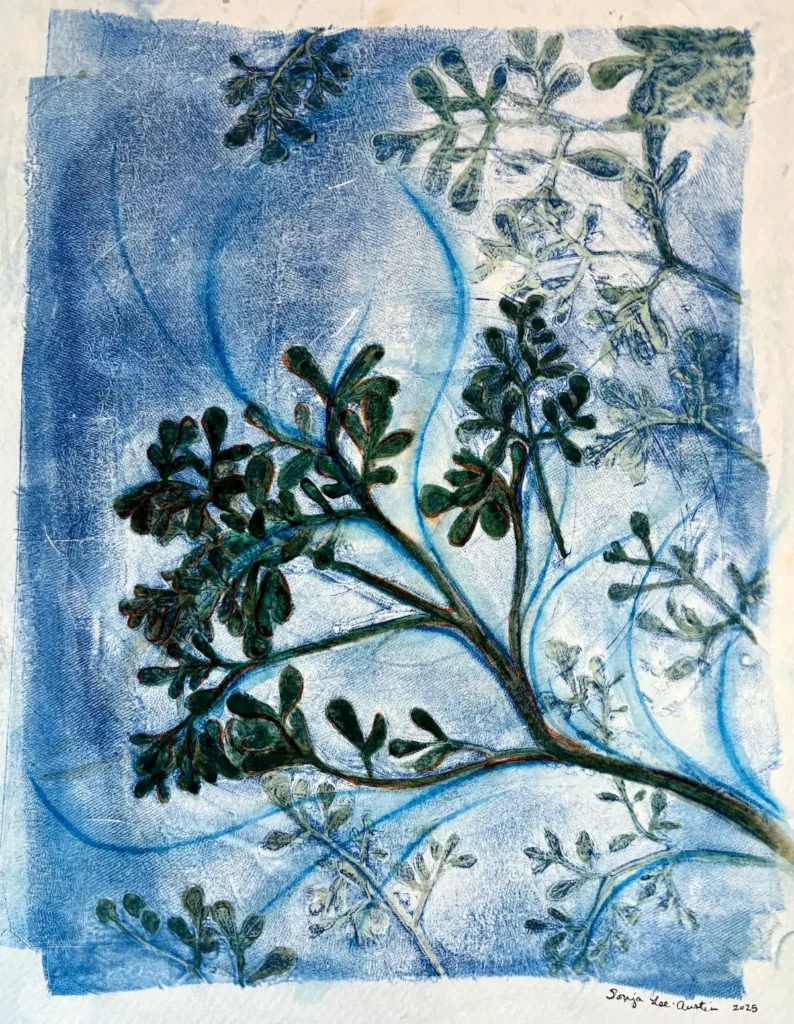


Has there been a time when doubt or fear made you question your path—and how did you move past it?
There have been a few times when I did not make much art such as when I first became a manager at my job and when my son was born. Both times felt barren for art making and creativity. My mom has always reassured me that we all have times of low energy and creativity and she reminded me of the small ways I kept creativity alive like baking bread or doodling in my notebook.
Sometimes I have questioned whether I should focus more of my energy on making my art practice a full-time paying career and sometimes I just enjoy having my other career life that makes it possible to have a studio space and lots of art supplies. I like to remind myself that I am not alone in being an artist with a separate career. For example, Wassily Kandinksy was a social scientist, Charles Ives – an insurance agent, and William Carlos Williams – a physician.
What lessons has your practice taught you about patience, resilience, or trust?
It has taught me to be resilient and trust the process
Your work has such a personal, layered feel—were you always drawn to expressing inner stories visually?
Yes, I think so although I don’t think I realized it until you asked me this question. It has been fun to ponder this question.
You layer materials in such a rich way—how do you decide which mediums to combine?
The way I combine media varies by the work. Similar to Ellie Harold’s description of her work in her YouTube Timestamp video (‘All I had to do was get my fear out of the way’ | Ellie Harold Timestamp – YouTube https://www.youtube.com/watch?v=Al1gdaMgF58), I have about three work streams, and each involves a different way of working.
1) For more symbolic work that has a story, the materials are chosen based on what works best to represent the story. It’s also influenced by whatever I’ve been learning and experimenting with at the time.

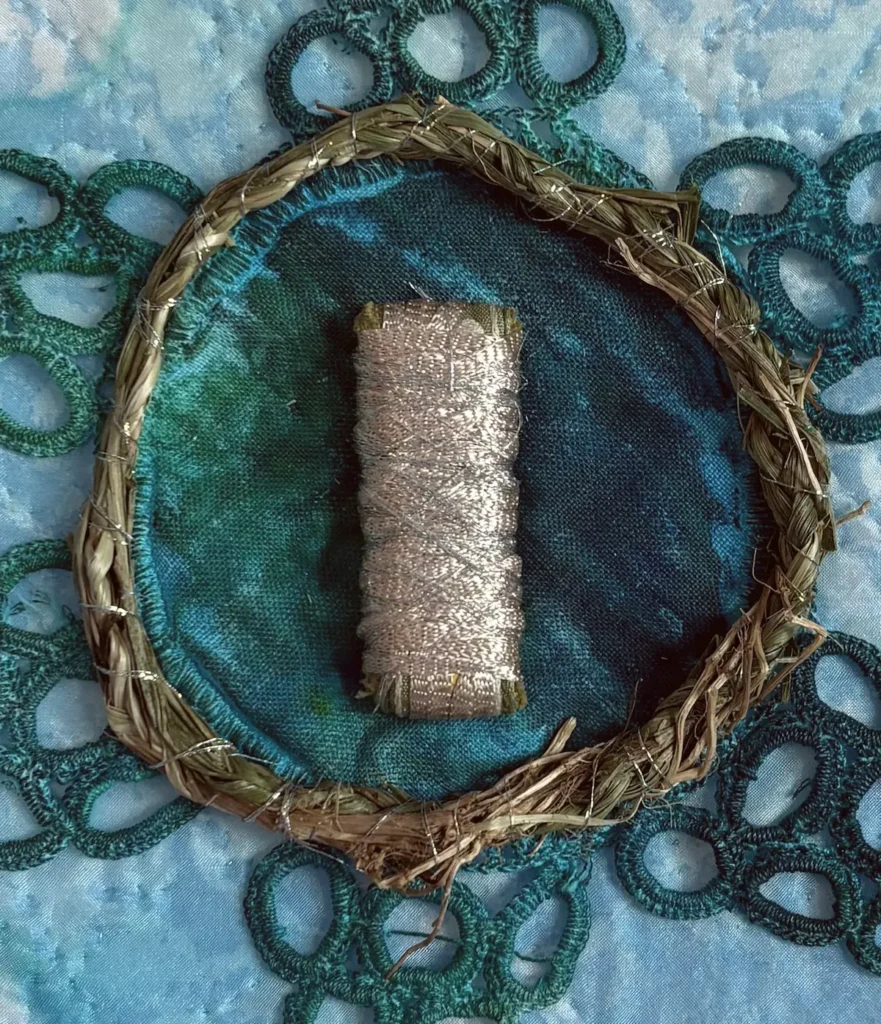
For my piece Mother/Not Mother, I had just taken an online freeform basketry class with Sarita Westrup through the Surface Design Association, and I was taking an online class on screen printing on fabric with Jane Dunnewold. The background fabric was created during Jane’s printing class, and the edging is made with the basketry techniques I learned from Sarita.
The fabric was chosen for being a calming shade of blue and having subtle patterning and the basketry was added because I liked how it was reminiscent of baby bassinets made with basketry or a nest. A halo of sweetgrass was added because I have a new love and fascination with sweetgrass from reading the book “Braiding Sweetgrass” by Robin Wall Kimmerer and I had started to grow it in my garden. The center bundle was made to represent the baby fetus that I had miscarried. The piece gave me a chance to honor that tiny spark of life that lasted only a brief while.
For the piece That Than Which I knew I wanted to combine a range of colorful and shimmery materials with fabric and machine stitch to represent the dichotomies of life, such as night and day, fire and water, light and dark, etc.


2) My second main workstream is art that celebrates the wonder and beauty of nature. These works tend to be art quilts with photographs printed on fabric and then painted and machine and/or hand stitched. Sometimes additional embellishments get added. The imagery is combined in a manner that creates balance and flow between the images. Painting and stitch help to create a sense of flow around and through the imagery.




3) The third work stream is art that is created just for fun when I experiment and play with materials. There is no plan. It’s more like meditation where you just go with the flow and see what happens.
I recently took Jane Dunnewold’s Dye Mastery online class for the second time so I have been experimenting with mixing colors and folding and tying shibori or tie-dye patterning to see what I get and then taking notes on the results so I can repeat the color ways and patterns that I like best.
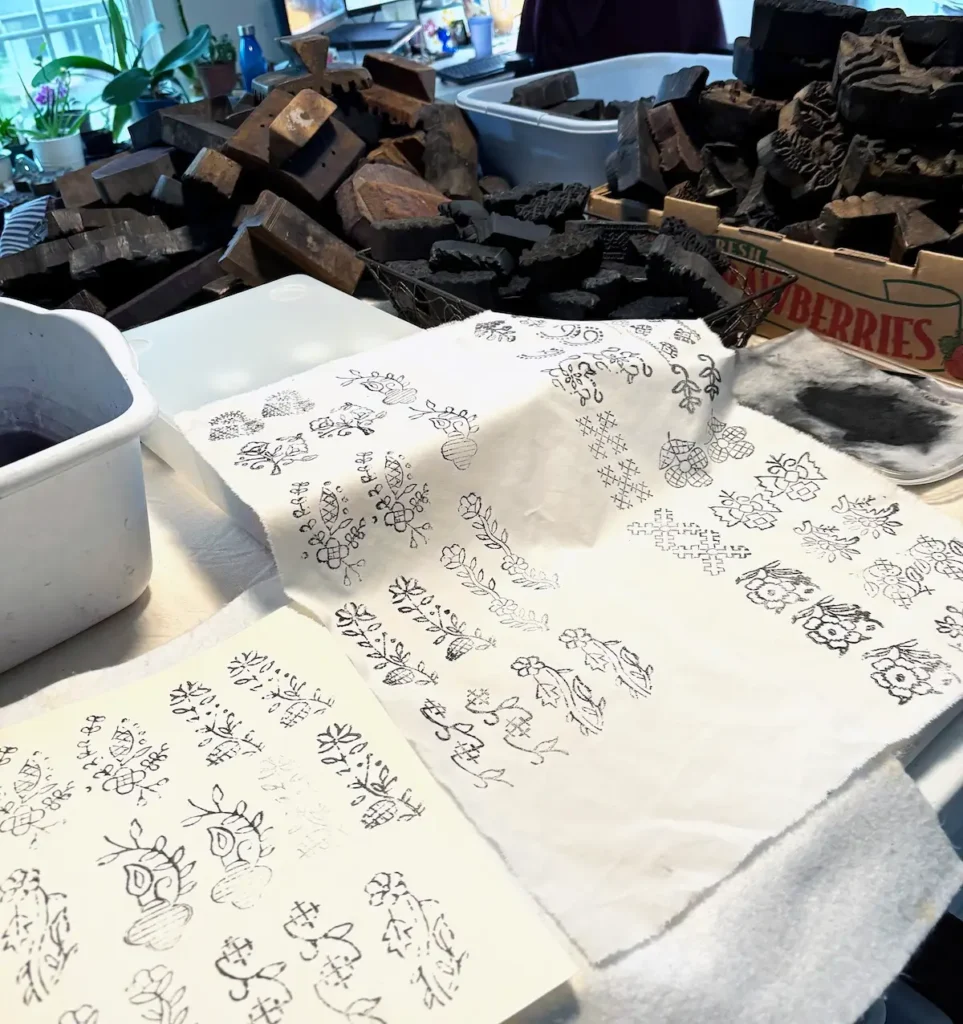

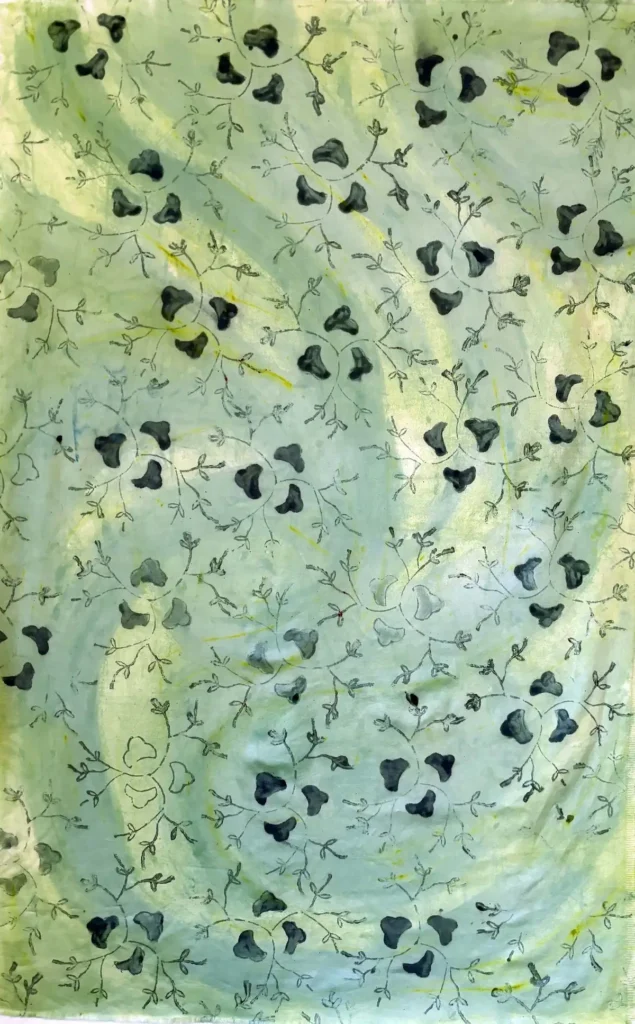
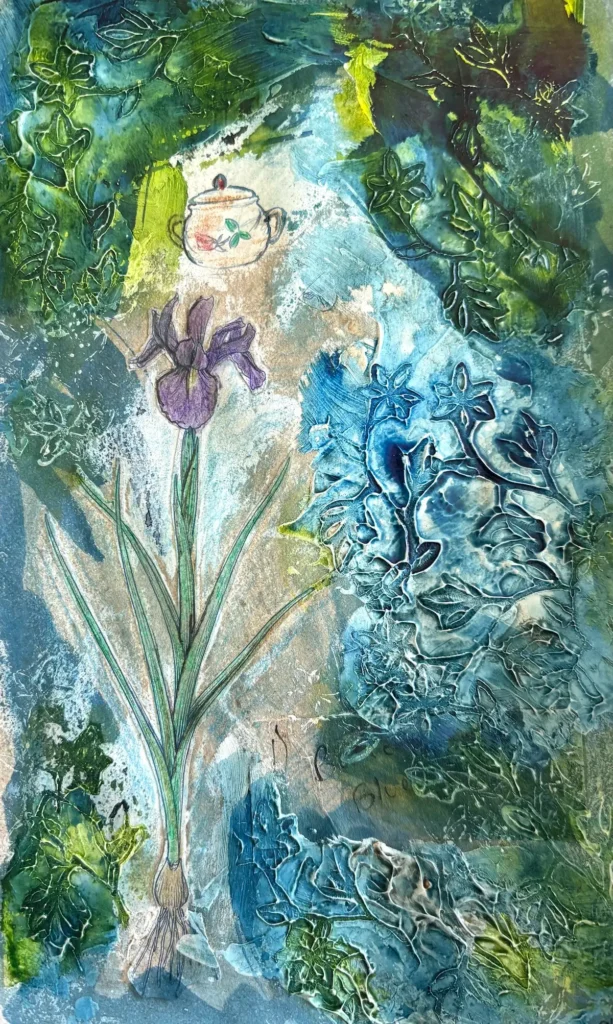
I also scored a great deal on a ton of antique hand-carved wood block stamps at a local vintage shop so I have been having a lot of fun seeing what I can do with those, too. I bought all 200 or so because I couldn’t stand the idea of them not being able to still be used. Jane Dunnewold told me the late Els van Baarle learned a lot about them and how to use them. She said that the ones I bought are considered to be done/not useful anymore. They do not print as clearly as they used to, but I love how that adds a wabi-sabi, beauty in imperfection, aspect to printing with them. I have sold some on my website, but there are still a bunch there for sale, if any of them call to anyone else. They are all unique. It feels decadent to have so many of them for just myself.
I wrote a creative ideas and tips article on them, if anyone could use a few ideas on what to do with them or they just want to check out what I’ve tried with them so far: https://www.sonjaleeaustin.com/s/stories/experimenting-with-antique-hand-carved-wood-block-stamps Next up is to play with them on the gel plate since I’m addicted to Jane Dunnewold’s workshops so I am now enrolled in her Poetic Cloth – Gel Plate Printing on Cloth on-line course.

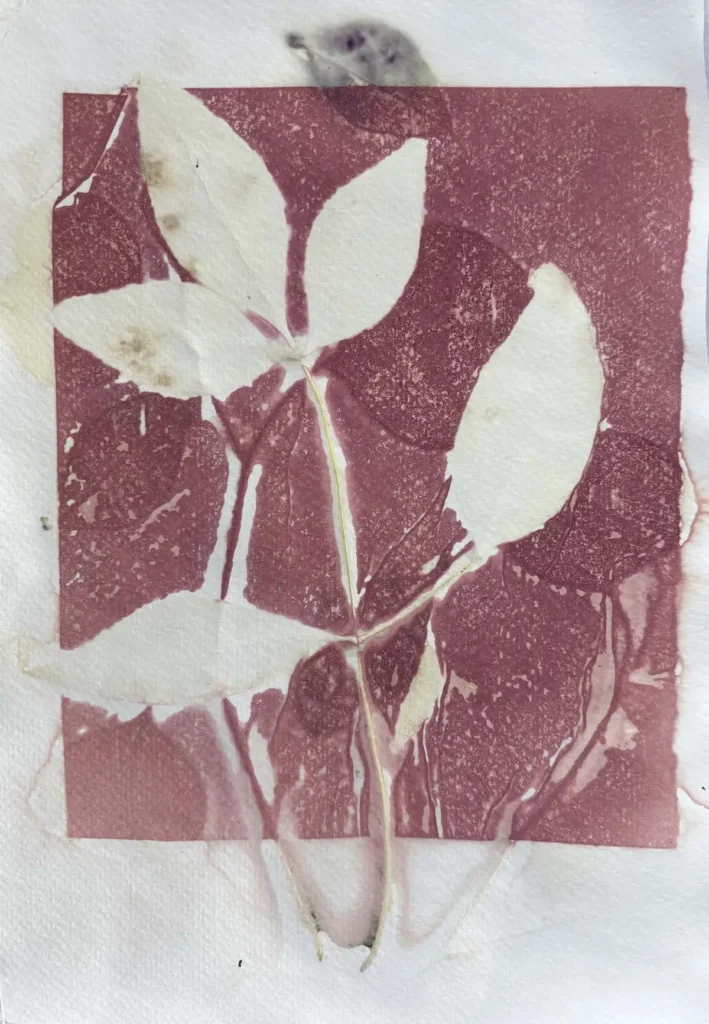
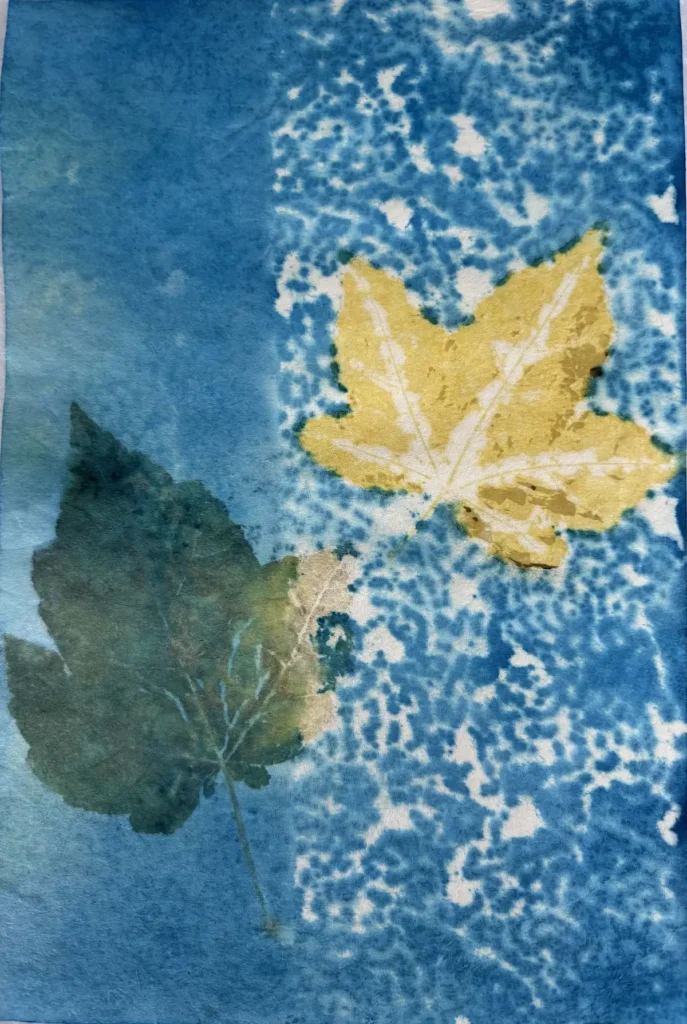

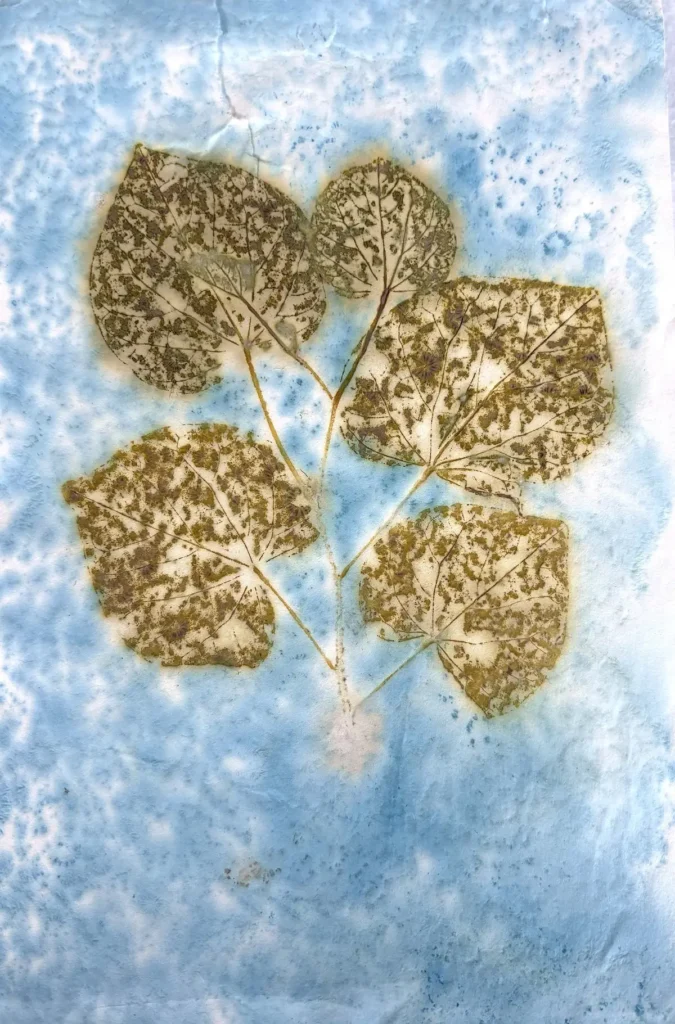
How do you balance freedom and control when working with so many layers?
It just happens as part of the meditative flow of the process. If the process isn’t flowing the work just doesn’t work so I either have to get back into the flow meditative state somehow or move on to something else. If I get stuck, usually taking a break helps or switching to doing something else for a while. I do have a pile of pieces that I never finished. Maybe someday I’ll do something with them, but maybe not.
Your work often blends natural textures with symbolism—where do those inspirations come from?
Inspiration comes from all manner of things such as nature, color, reading, the study of archetypes, architecture, art history, the study of religion and philosophy (mainly from a college series of courses called “The Great Conversation” where we read a broad range from religion to art history to philosophy and more), and just enjoying the process and materials.
I’m very curious, so I am continuously learning something new. Whatever I’m focused on at the moment tends to inspire artwork in some way.

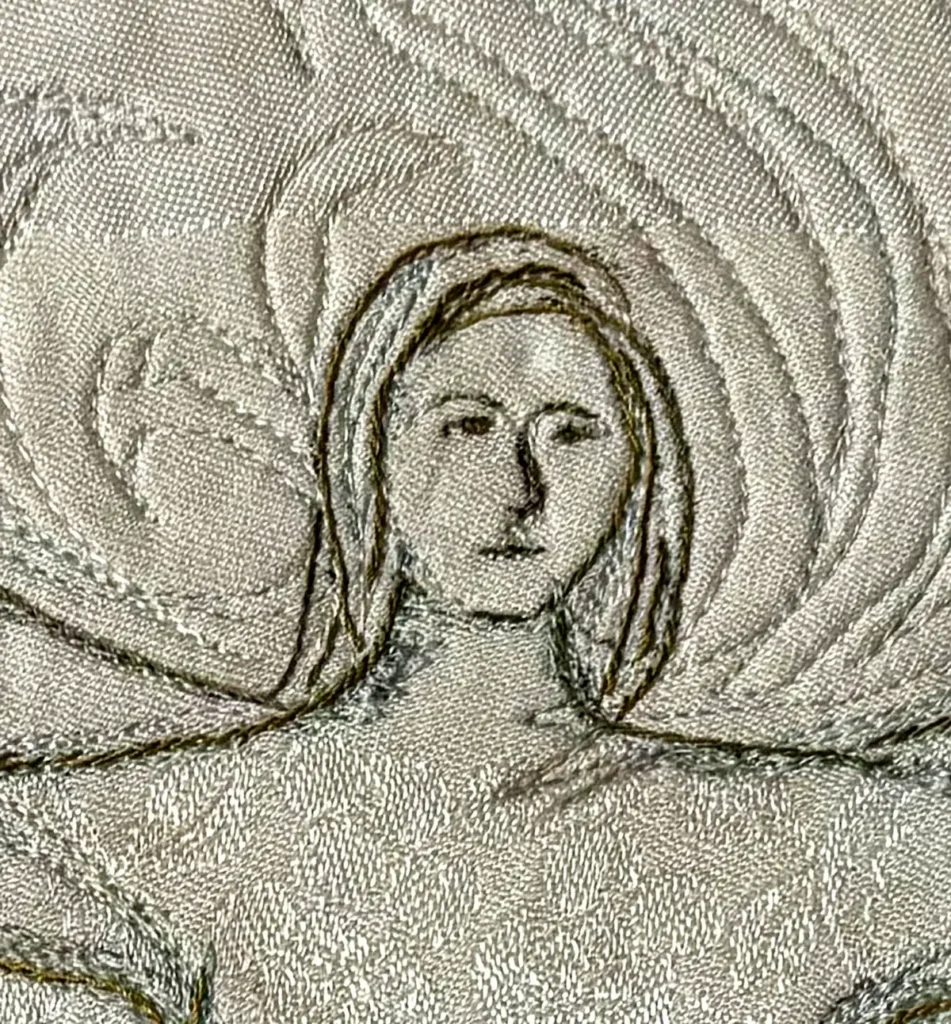
Are there particular symbols (birds, trees, circles, patterns) that hold special meaning for you?
Circles, spirals, mandorlas, mandalas, and yin/yang symbols all have a rich history of symbolism that I relate to and incorporate in my work
Do you see your work as storytelling, meditation, or exploration—or maybe all three?
Sometimes meditation, sometimes experimenting/exploration, and sometimes all three
When you begin a piece, do you start with a clear vision or let the work guide you?
It varies generally according to the three work streams mentioned above. Sometimes I work out a piece with sketches, notes about what materials make sense, and make templates as needed. Other times I just play and see what happens. I like to do a lot of creative experiments with surface design techniques from dyeing fabrics to screen printing on fabric to botanic printing with a heat press in the manner that Jane Dunnewold invented.
How do you know when a piece has reached that moment of “completion”?
It feels done usually. If I’m not sure, I’ll ask my mom, Ann Lee, and my aunt, Sue Gilleland what they think on a family art video call night. That usually helps me resolve whether I’m sure it’s done or if the piece still needs something to complete it.
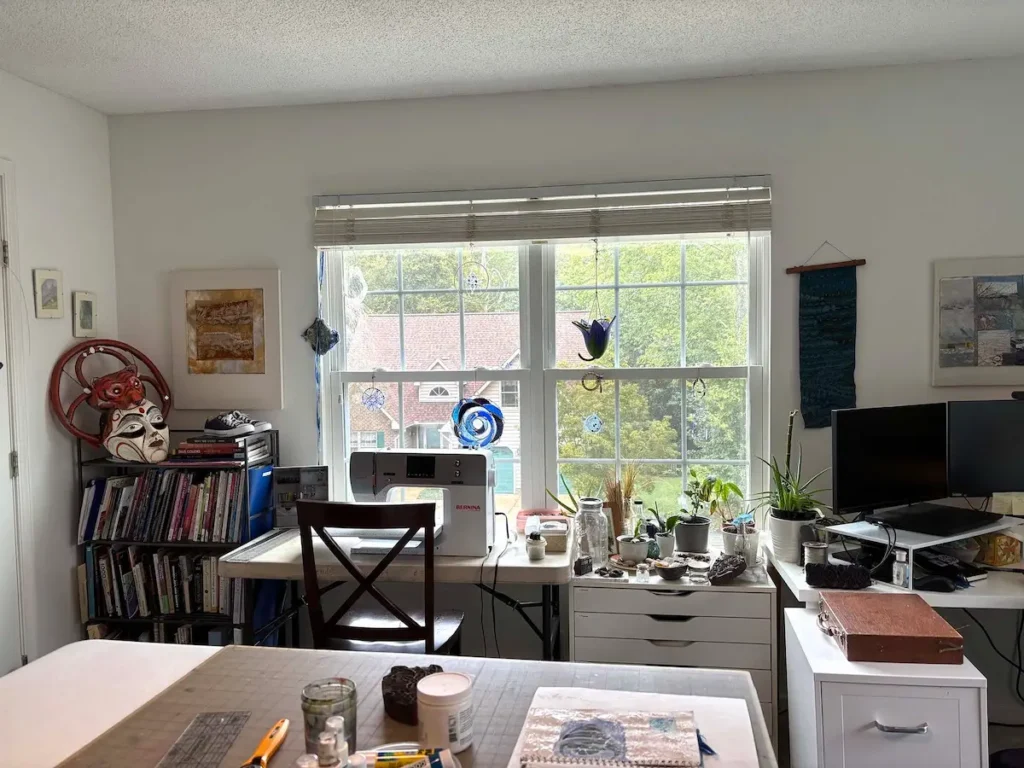

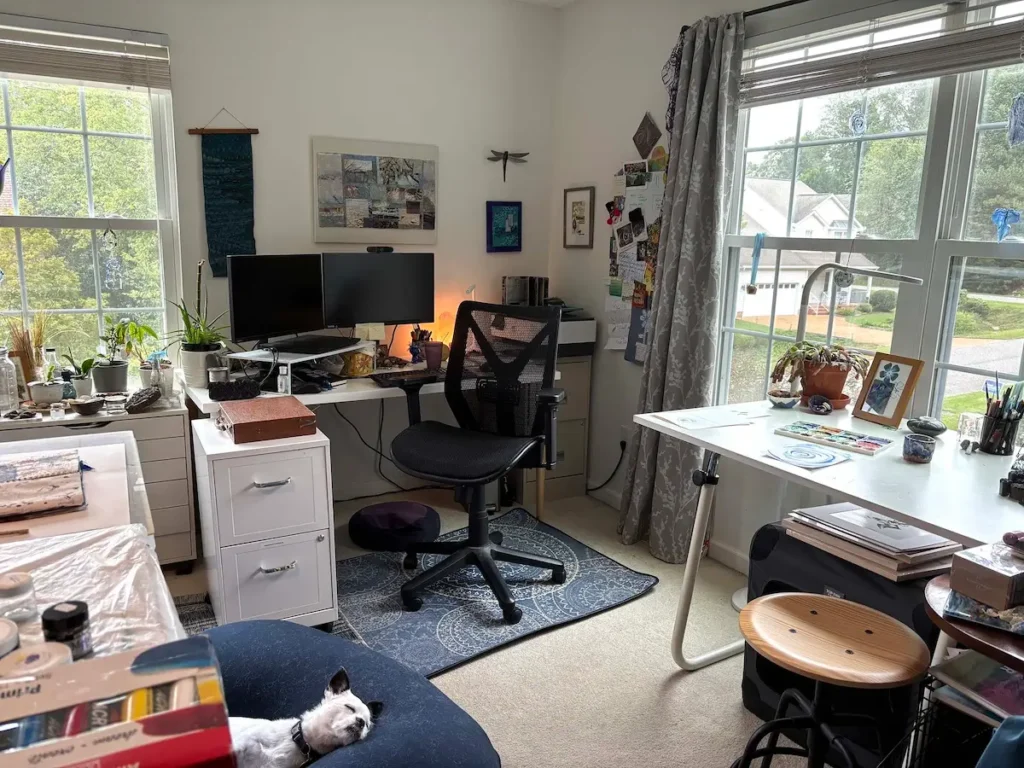
What does your ideal studio day look like?
Having playtime, making a mess, and going with the flow of doing whatever draws my attention that day
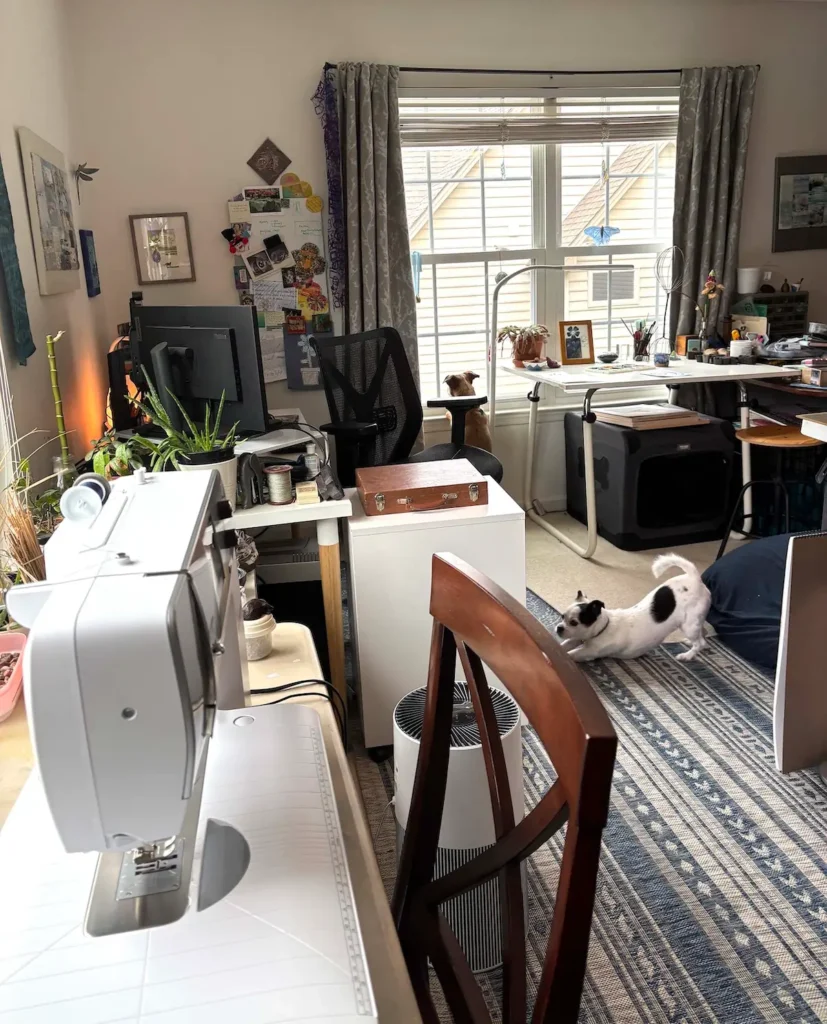


Do you have “go-to” tools that always feel like an extension of your hand?
I love all manner of art materials. I always enjoy learning something new but here are a few:
- A # 2 round watercolor brush
- A Pigma Micron #5 Ink drawing pen
- My Bernina B770 Quilter’s Edition sewing machine that has a free motion foot (it’s amazing how much easier the free motion foot technology makes free motion stitch without a jumbled knot of thread on the back of the fabric!)
- Hand sewing and embroidery needles and thread
- A silk screen squeegee and silk screen
- Scissors
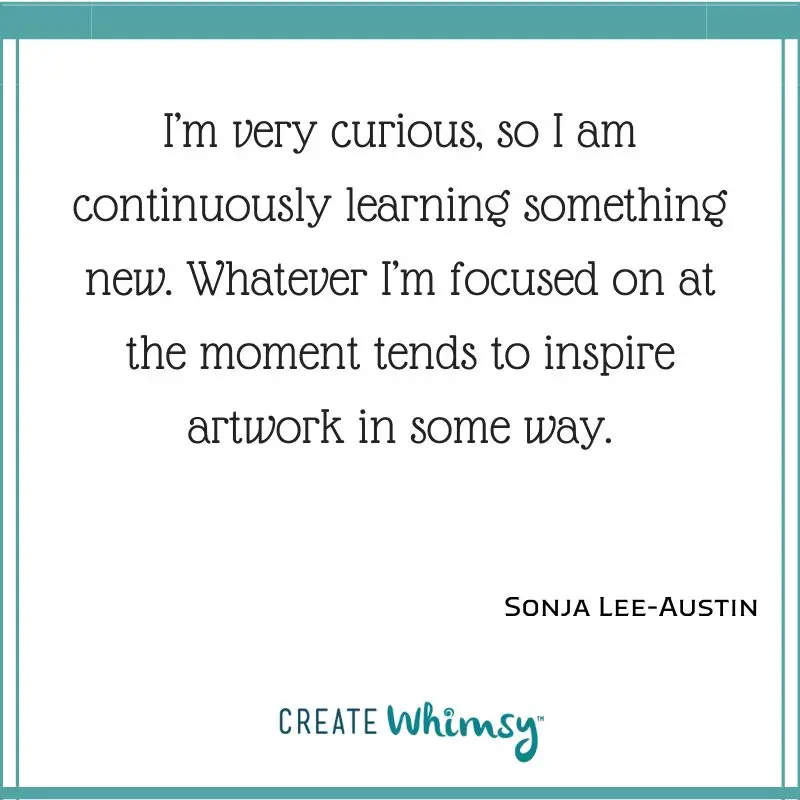
Where can people see your work?
Currently the main place people can see my work is on my website: https://www.sonjaleeaustin.com/
Instagram: https://www.instagram.com/sonjaleeaustin/
Surface Design website: https://www.surfacedesign.org/author/slaustin/
I’m also a member of Jane Dunnewold’s Creative Strength Training community so members of that group can see some of my recent experimenting there: https://www.janedunnewold.com/cstonline
If anyone is in the Williamsburg Virginia area, I’m more than happy to meet other art and surface design enthusiasts and give a home studio tour.
Interview posted October 2025
Browse through more inspiring art quilts on Create Whimsy.

